Bone Cancer:
Table of Contents:
- What Is Bone Cancer?
- What Are The Types Of Bone Cancer?
- What Are The Symptoms Of Bone Cancer?
- What Causes Bone Cancer?
- How Is Bone Cancer Diagnosed?
- How Is Bone Cancer Treated At Different Stages Of Treatment?
- How Can We Prevent Bone Cancer?
- How Punarjan Ayurveda Treats Bone Cancer?
- Our Bone Cancer Survivor Stories
- FAQs?
The term “bone cancer” does not occur in cancers that begin within the body and unfold to the bone. Those cancers are identified wherever they are started, like carcinoma that has metastasized in the bone.
Bone cancer can begin in any part of the body; however, it mainly affects the ordinary pelvis or the long bones with Cancer is one of the foremost deadly diseases in the twenty-first century, and has currently become the prominent dangerous killer within the world Health Organization. The United Nations agency will deny that cancer is expounded to somebody of modernization and an advanced pattern of irregular and stressed life dominated by Western medication. Scientists are giving their best efforts to fight us from cancer disease; the sure-shot cure remains hoped-for the best.
Bone cancer is rare, creating up but one % of all cancers. Non-bone tumors are known as cancerous ones.
1. What is Bone Cancer?
Bone is one of the supporting frameworks of the body. The bone is hollow in structure, and the outer layer of the bone consists of a network of fibrous tissues commonly known as the matrix. At every end of the bone could be a cartilage zone, a softer type of bone-like tissue. Cartilage tissue consists of a fibrous tissue matrix that mixes with a gel-like substance. Cartilage tissue acts as a cushion between bones and, at the side of ligaments and a few various tissues, forms the joints between bones.
It discovered the bone’s outer layer with fibrous tissue, known as a tissue layer of Periosteum. The bone contains a pair of forms of cells. The bone cell is responsible for forming the bone, and therefore the bone cell is responsible for dissolving the bone. Bone marrow is known as the soft tissue within the hollow bones. The marrow of bones consists of fatty tissues. The marrow of different bones can be a mixture of fat cells and blood-forming cells. These blood-forming cells are manufactured in red blood cells, white blood cells, and blood platelets. There are other cells within the marrow like plasma cells, fibroblasts, and reticuloendothelial cells.
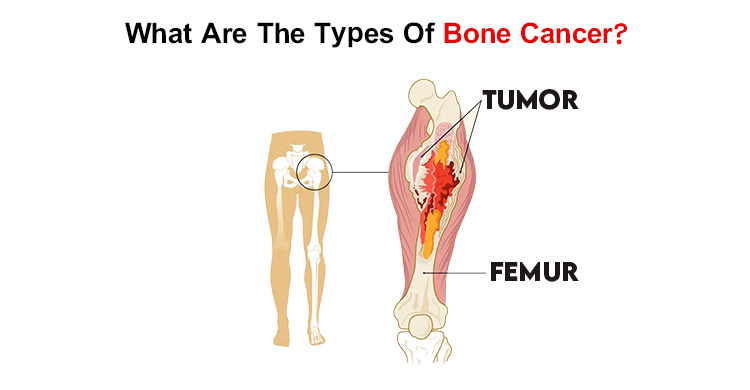
2. What are the types of Bone Cancer?
Bone cancers are de-escalated and separated by the various kinds of cells wherever cancer begins. The primary common forms of bone cancer include:
There are two subtypes of Bone cancer:
- Primary Bone Cancer
- Secondary cancer
In Primary Bone cancer, these are the types:
- Osteosarcoma: Osteosarcoma is the most typical type of bone cancer. During this tumor, the cancerous cells manufacture bone. This type of bone cancer happens most frequently in youngsters and young adults, within the leg or arm bones. In a rare case, osteosarcomas will arise outside of bones (extraskeletal osteosarcomas).
- Chondrosarcoma: Chondrosarcoma is the second most typical type of bone cancer during this tumor; the cancerous cells manufacture animal tissue. Sarcoma typically happens within the pelvis, legs, or arms in old and older adults.
- Ewing sarcoma: Ewing sarcoma tumors most ordinarily arise within the pelvis, legs, or associates of youngsters and young adults. This type of cancer can occur in the age of 5 to 20s ages of people.
Though it occurs in the bone known as multiple myeloma, which is not primary bone cancer, it is known as your Marrow, a soft tissue present inside the bones.
Secondary Bone Cancer
Cancer usually starts in the bone or else everywhere in the body. Cancer spreads into the body; it is known as secondary bone cancer; if any cancer spreads from one part to another, it’s known as metastatic cancer.
3. What are the symptoms of Bone Cancer?
Symptoms of Bone Cancer:
(A) Pain: – Pain within the affected bone is that the most typical criticism
(B) Swelling: – Swelling within the affected area
(C) Fractures
(D) Generalized symptoms: – If cancer has spread, it can cause several symptoms in different parts of organs.
(E) Weight loss.
(F) Feeling tired.
(G) No proper Sleep.
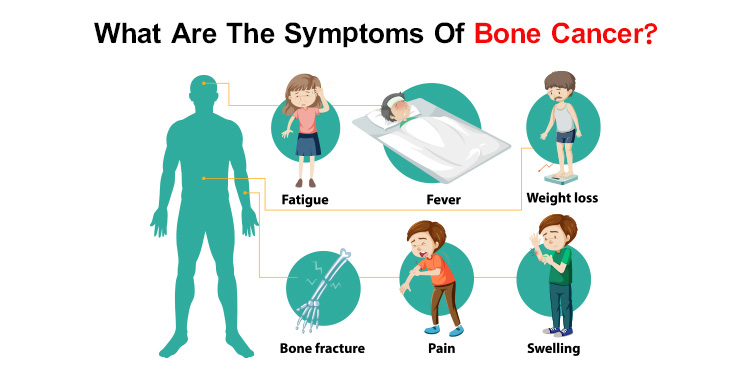
4. What Causes Bone Cancer?
The reason behind most bone cancers is unknown. A range of bone cancers is related to hereditary factors, whereas others are associated with previous radiation exposure.
What are the risk factors of Bone Cancer?
Some of the Risk Factors:
(a) Familial genes
(b) Paget’s illness
(c) Multiple exostoses (overgrowth of bone tissue)
(d) Multiple osteochondromas (benign bone tumors)
(e) Multiple enchondromas (benign animal tissue tumors)
(f) Radiation
(g) Bone marrow transplantation
(h) Injuries
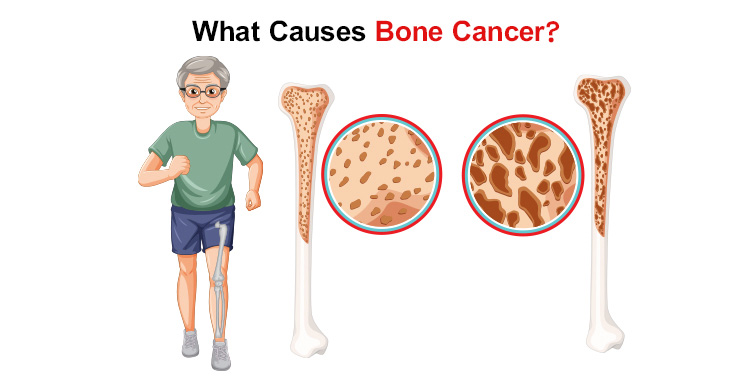
5. How is Bone Cancer Diagnosed?
Your doctor will ask you about your medical history or family’s and tells you to perform some examinations after seeing the bone images will prefer you for future which tests you have to take
X-ray: Doing a chest X-ray also tells you where the tumor is located.
CT scans: In this, it will show how far cancer has spread in the body
MRI: Scanning MRI will show you the outer boundary of the tumor.
PET scans: This PET scanning is helpful for testing whole-body cancer.
Radionuclide bone scans: Bone scans & tells you that cancer has spread to other bones of the body; it can identify in the smaller areas of metastasized than doing X-ray.
Your doctors will tell you the procedure of some sample of tissue known as a biopsy. Getting a test done, your doctor will suggest what type of cancer the tissue. It can tell you that your tumor cells are growing quickly or slowly.
Getting biopsy treatment done, you need to plan the procedure with your doctor’s team carefully. If you are done with the biopsy surgery, future surgery won’t interfere with removing bone cancer.
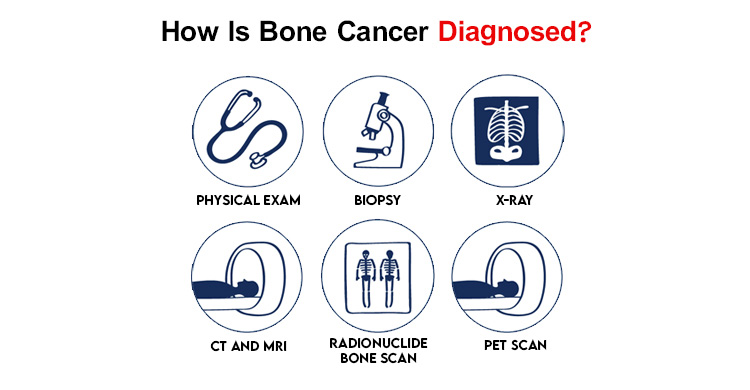
How is Bone Cancer treated at different stages of treatment?
(i) Stage I: – The tumor is low grade and small in size, and has not spread.
(ii) Stage II: – The tumor is high grade and bigger, and it’s not spread.
(iii) Stage III: – The tumor is of any grade; however, it does not spread.
(iv) Stage IV: – Cancer has spread to the lymph nodes and distant sites, apart from the respiratory organ.
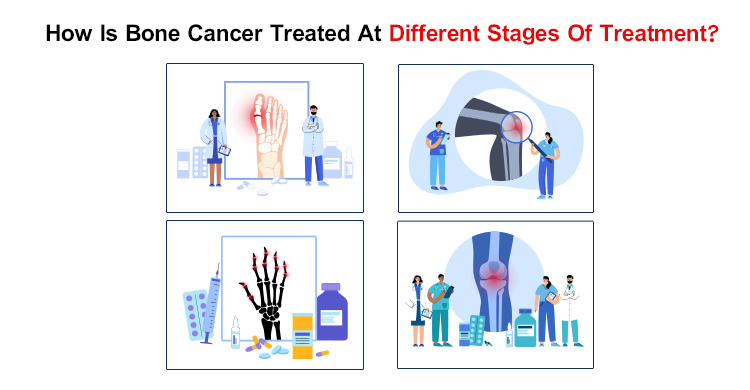
What is the Treatment for Bone Cancer ?
There are many forms to treat bone cancer:
Surgery for Bone: Doctors will remove the tumor where the tumor tissue is affected. Surgery is to stop cancer from spreading.
- Radiation therapy: In this therapy, doctors will kill the tumor.
- Chemotherapy for bone cancer: Chemotherapy methods operate as a part of osteosarcoma. It will transfer the red blood cells; with white blood cells; if they are slow, to undergo chemotherapy, you have to take the sessions for several weeks.
- Targeted therapy: In this therapy, doctors use the drug called Denosumab to prevent osteoclasts from identifying which type of blood cells are and stop them from destroying the bone tissues.
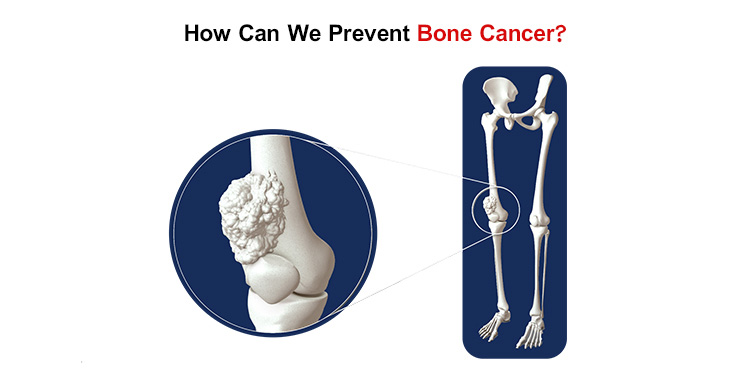
6. How can we prevent Bone Cancer?
There is not yet any proof to get prevents Bone cancer; the thing we can do is that:
• If someone has cancer means you need to know the first family history that your family had suffered or no before to avoid cancer
• Do some regular exercise, yoga, and meditation to keep your body and mind cool and calm?
• Take proper diets which are high in nutrients and liquid fluids more.
• Avoid diseases.
• Avoid eating tobacco, smoking, and drinking alcohol.
• If you have bone cancer, then getting treatment at the early stages is best to avoid spreading cancer.
What are the survival rates of Bone Cancer?
The survival rate of Bone cancer is at least five years after diagnosis. Bone cancer can cause problems heart, lungs, brain, and fertility. So you need to do regular follow-ups and follow what doctors tell you, and the overall percentage of spreading bone cancer is nearly 75%. So getting early treatment is the best remedy to avoid much more risk of Bone cancer.
7. What are the facts about Bone Cancer?
Bone cancer starts in any part of the body or bone; it majorly affects the pelvis region or the long bones of the body like arms and legs. Bone cancer is common cancer; it has less than one percent seen in people. It is known as a non-cancerous tumor rather than any other cancers.
• All bone tumors are non-cancerous
• Generally, cancer is occurring in metastatic or secondary diseases of small cancer.
• Bone cancer can be treated by doing surgery, chemotherapy, radiation therapy, and targeted therapy.
• Will give treatment depending on the size of the tumor, how much dimension it has grown and how it has spread in tissues; according to that, doctors will suggest to you what treatment should take.
Living and Managing with Bone Cancer:
Some people who are suffering from bone cancer can be treated and can remove or destroy cancer. After completing the treatment, you feel relaxed and stressed. Bone cancer might not go for some people completely; they need to do regular follow-ups and take medicine with chemotherapy and targeted therapy or other therapies to check for cancer. Learn to live with cancer because you might have chances of getting it back, so learn to fight with cancer.
8. How Punarjan Ayurveda Treats Bone Cancer?
We stand as a promise for cancer patients today. Our success stories are in hundreds beaconing the ray of hope in the field of cancer treatment. We are committed to provide a complete and unique treatment plan in cancer treatment. According to ayurveda, the human body can heal itself. Besides, it can regain equilibrium too.
To treat cancer, the primary focus of a skilled Ayurvedic practitioner should be the root cause and not the symptoms.
Hence, it is our way of treatment where we enhance natural immunity to fight cancerous cells. In order to achieve this, the sufferer has to go through a combination of herbal medicines and dietary changes. Our individual treatment plans consider the patient’s condition and cancer stage in the first place. However, Punarjan Ayurveda’s strategy walks beyond physical aspects. We are aware of the psychological toll that bone cancer can take on people today. As this is a holistic approach, we are here with faithful help and direction all through this cancer treatment venture. Indian Ayurveda states that human beings are able to actively participate in their own healing. Working together to make promising decisions, we keep track of progress, encourage communication, trust, and collaboration. More than 2 decades of research and around 1 decade of cumulative success, Punarjan Ayurveda is a path that emphasizes individualized care, Ayurvedic wisdom, and a supportive community.
“Join our journey into a cancerfree world”
Bone Cancer Survivor Stories
9. FAQ’s?
What Are The Early Warning Signs Of Bone Cancer?
Cancer’s early warning signals are frequently identical to other prevalent ailments, making them easier to overlook. Every symptom should be taken seriously, especially if it persists or worsens over time.
- Swelling and lump formation
- Bone fractures
- Bone weakness
- Fatigue and unexplained weight loss
- Fever
- Skin Changes
- Change In Bowel Habits or Bladder Function
- Unusual Bleeding or Discharge
Is bone cancer cured?
Where does bone cancer usually start?
Bone cancer usually begins in the cells that form our bones. It can start in any bone, but it commonly develops in the long bones of our arms and legs, like the thigh bone (femur) or the shin bone (tibia). Occasionally, bone cancer can also originate in the pelvis, shoulder, or spine bones.
These cancerous cells grow and multiply irregularly, creating a tumor inside the bone. Over time, this tumor can weaken the bone, leading to pain or fractures.
At what age does bone cancer start?
What is the first stage of bone cancer?
Can bone cancer lead to death?
Bone cancer can kill, but it doesn’t always. Remember that many bone cancer patients recover and live normal lives following therapy.
Indian bone cancer survival rates depend on many factors. These include cancer kind, stage, patient age and condition, and treatment efficacy. India’s five-year bone cancer survival rate is 60%–70%. Bone cancer survivors have a 60–70% chance of surviving five years.
Can anyone survive bone cancer?
Early detection and treatment can cure bone cancer. Bone cancer patients in India have many therapy choices, including Ayurveda. Bone cancer mortality rates depend on stage, type, patient health, and treatment.
Ayurveda, a holistic Indian medicinal system, is well-known. Punarjan and Rasayana Ayurveda are important cancer treatments. Ayurvedic remedies harmonize the body, mind, and spirit to boost the body’s natural healing abilities.

